
- This event has passed.
1st International Scientific and Family Conference on Glycoprotein Storage Diseases
April 1, 2004 - April 4, 2004
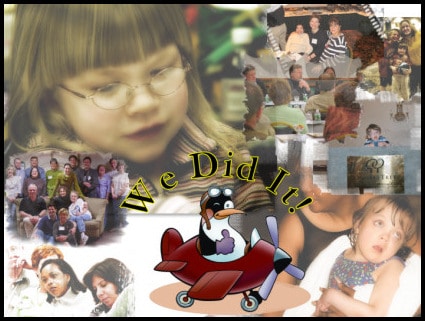
An historic four-day event for Glycoprotein Storage Diseases occurred April 1-4, 2004 in Rockville, Maryland.
This event witnessed the first professional and family conference on these diseases held anywhere in the world. On April 1 & 2 the National Institute of Neurological Diseases & Stroke (NINDS) sponsored a rare disease workshop titled The Glycoproteinoses: An International Workshop on Advances in Pathogenesis & Therapy. The program for professionals was put together by a committee including Steven Walkley, Alessandra d’Azzo and Leena Peltonen and involved almost 50 invited experts from around the world. From April 1-4 ISMRD simultaneously sponsored its first Family Conference, which featured a day-long program led by many of the scientists involved in the Workshop, disease focus groups for families affected by similar diagnoses and a Sunday strategy session for attending parents with the ISMRD Board of Directors. Other highlights included a Children’s Program involving games and activities while parents attended various meetings, a Thursday evening reception for scientists and families and a Gala Dinner Friday night. At the dinner, Christopher Llewellyn Reed premiered his forthcoming documentary film about Taryn Murphy and Alpha-Mannosidosis.
This conference enabled scientists and clinicians to share the latest techniques and strategies for furthering understanding and eventual treatment of all nine diseases. For families it was a rare chance to meet other parents and children affected by these diseases and to talk one-to-one with many of the participating scientists. Children who attended had more fun than the adults, thanks to a superb program developed by Children’s Program Coordinator, Sandy Miller. For ISMRD’s Board of Directors, it was a special opportunity to finally meet the constituency its serves and to share ideas that will make ISMRD a more effective advocate for all of them.
Reflecting the true global reach of these diseases, despite their very rare nature, attending families (like the scientists involved in the Workshop) came from diverse locations. Among the countries represented by our families were Canada, New Zealand, Australia, England, France, Norway, Latvia and the United States. Though language was quite a challenging obstacle for some, it did not prevent them from enjoying an overall exhilarating and informative experience. All of us were especially affected by children like Paul Grégoriadès of France and Stanislav Sovetchenkov of Latvia, whose smiles belied their inability to communicate in English!
The conference could not have taken place but for the dedication of several key people, who worked diligently for almost a year prior to April 1. Among those we would like to single out for our deep appreciation are the following:
Steve Groft, Director of the Office of Rare Diseases
Danilo Tagle, Ph.D., Program Director for NINDS
The Organizing Committee comprising Dr. Steven Walkley; Dr. Alessandra d’Azzo and Dr. Leena Peltonen
Dr. Emil Kakkis, Senior Vice President of BioMarin Pharmaceuticals
Sandy Miller and Debora Murphy and Gretchen Oswald of ISMRD.
These individuals gave willingly of both their commitment to the ideals of this conference, as well as their time, sacrifice and support!
This first conference on Glycoprotein Storage Diseases is but the end of one journey that ISMRD embarked upon when it formed in March 1999. We now face a future of continued challenges for these diseases, but one of great potential whose ultimate goals will be the realization of effective treatments and therapies for all.
ISMRD Family Conference
There were so many highlights to our conference, many not readily interpreted into words, that we cannot possibly fit them here. We owe much to the families who traveled long distances to join us, and to the professionals who gave their time and expertise, so that we might leave more knowledgeable and empowered than when we arrived. Above all, thank you to the Office of Rare Diseases for supporting conferences on rare diseases such as this!
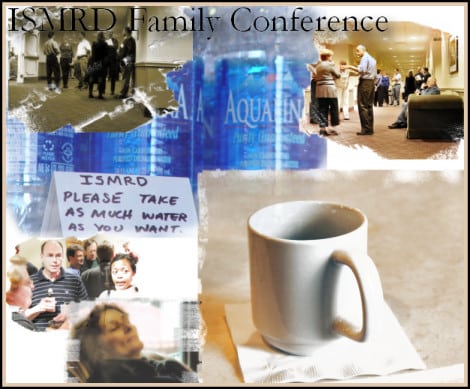
Children’s Program April 2-4:
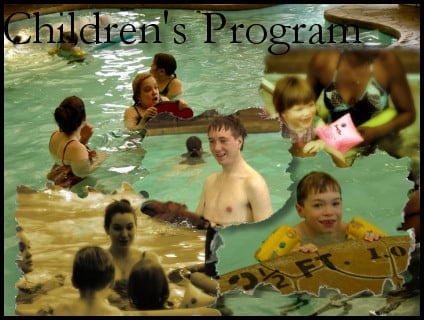
Not to be outdone by their parents, children who attended ISMRD’s Family Conference were given special focus through a wonderful program of activities Friday to Sunday.
Thursday & Friday, April 1-2:
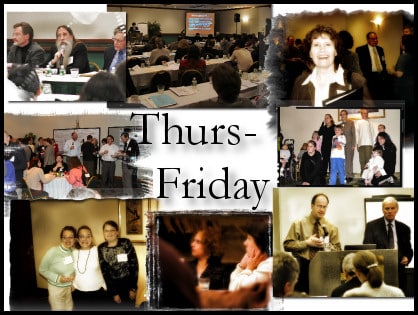
Day One and Two of the NIH Scientific Conference was one filled with difficult and technical information for families. Families were invited to observe these all day sessions as part of their conference registration, and gave many their first opportunity to see and hear those who have been or are considering studying their diseases. At the conclusion of the Workshop Friday afternoon, ISMRD President Paul Murphy led a group of parents and children to the podium to personally thank the Workshop participants for their involvement. Late afternoon Friday featured focus groups for families with similar diagnoses.
Thursday evening ISMRD sponsored a reception for families and scientists and Paul Murphy presented Dr. Steven Walkley with a special plaque in recognition of his crucial part in this conference. Friday night ISMRD sponsored a gala dinner, at the conclusion of which Christopher Reed premiered his film documentary about Taryn Murphy and Alpha-Mannosidosis.
Saturday, April 3:
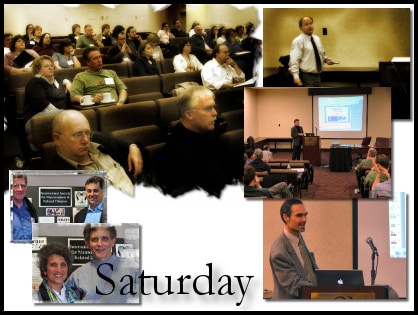
A day-long series of presentations from professionals marked Saturday’s events. The day was divided into two parts: What Is Known and What Can Be Done. It began with a humorous, delightful and understandable overview of Lysosomal Diseases by Dr. Kelley Moremen. Other presentations looked at the molecular mechanics of Glycoprotein Diseases; the role animals play in research; the clinical impact on patients and how to manage the symptoms; potential therapeutic remedies in the future; global cooperation among Lysosomal Disease organizations, science and the biotech industry and, finally, blood and tissue banking as a way to accelerate understanding of these diseases. At the end of the day we were all tired, but full of questions and ideas!
Sunday, April 4:
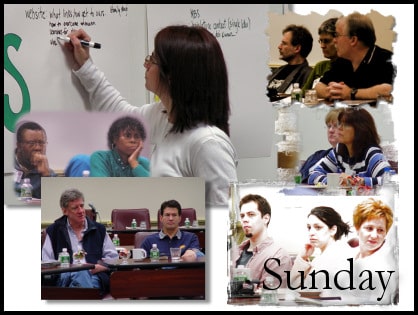
Families met for four hours around a large combination of tables, facing one another and sharing their hopes for the future. This hope was manifested in concrete ideas for ISMRD’s mission, which Board Member, Gretchen Oswald, recorded on large flip-chart pages. The meeting commenced with a brief summary of Newborn Screening developments from Dr. John Hopwood, which all felt was an important area for early and accurate diagnosis of these and other Lysosomal Diseases. Following this parents shared their common experiences and then participated in a free flowing exchange of ideas about how ISMRD can more effectively carry out its mission.
All parents present were resolute in their desire that Glycoprotein Storage Diseases take a more prominent place in global research projects. Each one attending left with new friendships and a common desire to ensure the continued momentum of the conference’s accomplishments.
ISMRD Children's Conference
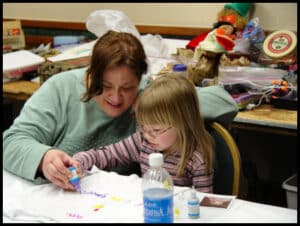
Image: Sandy Miller, Children’s Program Coordinator, with Anna James.
Since beginning our planning for the ISMRD Family Conference back in April 2003, we had looked forward to the opportunity for attending children to meet and interact with others similarly affected and their siblings. For many, this would be the first time they had ever met another child with the same diagnosis or one similar to theirs.
As the conference date approached, it became clear that the children’s program had taken on a life of its own! To enable parents to attend the Workshop and Conference sessions, the planning committee decided professional caregivers would be needed instead of parent volunteers. We also knew that it required someone extremely talented and versatile to develop and manage both the activities and the caregivers we needed to find.
After receiving no responses from postings on a Maryland Nonprofit volunteer website, I contacted the principal at my daughter, Taryn’s, school for help. She emailed ISMRD’s “volunteer opportunity” for a Children’s Program Coordinator to the school staff. After about a week (a very long week!), I was approached by one of the school Social Workers who wanted to know more about the position. She expressed that she was probably not qualified, having not done anything like this before. We talked for a few minutes, I gave her the best pep talk I could muster, yet she was still unsure and wanted to think about it. I did not want to leave without getting a commitment, however. After all, here was someone who was interested in a job that, until now, no one had wanted, and a job that desperately needed to be filled. This was a “moment of truth” when all pride goes out the window and one must do what needs to be done!
Therefore, in the busy foyer of St. Elizabeth School, with students running to their busses and staff mingling about, I got down on my knees and begged Sandy Miller to take the position of ISMRD Children’s Program Coordinator. Sandy was mortified! She begged me to get up off of my knees, but I told her I would do so only if she agreed to take the job. Sandy agreed and the rest is history.
I believe all those who attended our conference would agree with me that Sandy was not only qualified for the job, but developed a program that emphasized our children’s talents, recognized their different ages and abilities and provided a safe and loving environment for them to interact. I call Sandy a Godsend. Thank you, Sandy Miller, from all of us!
Glycoproteinoses: An International Workshop on Advances in Pathogenesis and Therapy, by Steven U. Walkley, V.M.D., Ph.D
This scientific workshop was led by Drs. Allesandra d’Azzo and Steven Walkley and attended by approximately 50 scientists from North America, Europe and the Pacific, all with interests and experience in the study of glycoprotein storage diseases. Many family members also attended the scientific sessions.
The meeting began with a series of lectures on how proteins are glycosylated (Dr. S. Kornfeld), how they are eventually degraded in lysosomes (Dr. B. Winchester), and what happens when defects occur in lysosomes which block this normal degradation (Dr. M. Patterson). In Session 2, mechanisms by which the inherited defects in lysosomes actually cause cell dysfunction and disease were explored. Dr. D. Marks, from the laboratory of Dr. R. Pagano, and Dr. S. Walkley spoke of the importance of secondary sequestration of cholesterol and glycosphingolipids and its potential consequences in lysosomal diseases. Dr. A. Cuervo discussed the degradation of cytosolic proteins in lysosomes and of the overall mechanism of chaperone-mediated autophagy. Drs. E. Neufeld and R. Proia discussed their studies on the importance of microglia and brain inflammation as participating in lysosomal disease pathogenesis, as well as possible significant differences between different types of disorders in terms of the microglial-mediated response. Dr. A. d’Azzo spoke of mechanisms contributing to neuron death in the lysosomal disease, GM1 gangliosidosis. Sessions 3 and 4 were focused on discussions of many available animal models of glycoprotein storage diseases as well as molecular mechanisms contributing to individual diseases. Included here were reports of glycoprotein storage diseases in mice, guinea pigs, cats, dogs, goats and cattle, and presentations by Drs. M. Haskins, A. Jalanko, J. Hopwood, D. Schindler, A. d’Azzo, P. Lobel, and W. Sly. There were also 2 sessions of speakers focused on therapeutic strategies in lysosomal diseases. Included here were reports on enzyme replacement therapy in alpha-mannosidosis by Dr. P. Saftig, mechanisms by which microglia may transfer enzyme to diseased neurons by Dr. K. Dobrenis, the use of cord blood and Hematopoietic stem cell transplants by Drs. M. Escolar and C. Peters, respectively, and the use of adenoviral and Lentiviral vectors for gene therapy by Drs. M. Sands and J. Medin, respectively. This session ended with a remarkable report on the use of an adenoviral vector for the treatment of brain disease in an animal model of alpha-mannosidosis by Dr. C. Vite.
Several new investigators to the field were also invited to attend the meeting and present their findings on lysosomal diseases, including Dr. Y-P Wu (mechanisms of inflammation in storage diseases), Dr. C. Tifft (surrogate markers of lysosomal disease progression), Dr. K. Ohmi (the role of gliosis in storage disease), Dr. M. Ellinwood (a newly discovered model of mucopolysaccharidosis type IIIB), Dr. M. Yoshimitsu (the use of Lentiviral vectors in gene therapy), Dr. G. Yogalingam (the use of PPCA as therapy for sialidosis) and Dr. D. Wang (enzyme replacement therapy in sialidosis and galactosialidosis).
The meeting closed with a roundtable discussion of pathogenic mechanisms, animal models, treatment strategies, future research priorities and research collaborations, and funding strategies, chaired by Dr. S. Kornfeld and addressed by Drs. M. Haskins, J. Hopwood, L. Neufeld, D Malm, and W. Sly. Consensus emerged on several points. Firstly, one of the major areas where our knowledge of glycoprotein storage diseases was believed most limited was in the actual mechanisms by which lysosomal dysfunction leads to cell and organ failure, particularly for brain as well as for bone and cartilage. Secondly, the availability of animal models of lysosomal diseases was viewed as a major research resource for both understanding issues of pathogenesis and for evaluating potential therapies. The one notable omission in terms of disease models was of a mouse model of fucosidosis, which many felt would be a major resource that should be developed as soon as possible. Finally, all agreed that the meeting had successfully brought together key leaders in the field, and that many new collaborations had been established and that additional substantial progress in understanding and in treating the glycoproteinoses could be anticipated.
Personal Reflections
The Longest Journey Begins With the First Step (by Jenny Noble, Mucolipidosis III Parent)
Mucolipidosis has taken a leap into the future and found a home! I want to thank Paul Murphy and his team of conference organizers for including ML II and ML III as part of ISMRD’s focus on the Glycoprotein group of diseases. The conference in Rockville was a truly amazing experience, the simplicity of the information given at the Family conference was just wonderful. Never in 17 years of diagnosis have we heard an explanation of how the enzymes get into the Lysosome explained so simply or in our case how the messages are missing on some of the enzymes. It is incredibly exciting seeing ML families finally uniting, sharing information and just supporting one another. During the conference we became known as the Stalkers, a group of parents crying out for information and answers. We used the weekend well to sow many seeds. Those poor Doctors must have wondered what they were up against, but it was a wonderful opportunity to spread the exciting results of Pamidronate treatment in ML2 and 3.
Our Journey with Pamidronate is a long one based on our efforts to firstly discover why Hayden and Sarah had so much pain and why conventional drugs didn’t work, but our involvement began when we started asking questions of all our International Experts, such as:
- Why do these children have such high levels of pain?
- Why don’t anti-inflammatory drugs work?
- If they don’t have arthritis what are we dealing with?
- We must be missing something there has to be an answer?
While attending an MPS meeting in Australia my husband, Paul, and I convened a medical meeting which consisted of one UK Dr, two Australian Drs, and New Zealand’s metabolic nurse. We were determined to come away from this meeting with a plan of action if not a possible treatment. The UK Dr had given a presentation about a list of drugs that help with some of the problems that MPS patients have. He mentioned a group of drugs called Bisphosphonates, which are useful for pain control. Finally a mention of a group of drugs that we had never heard of.
This possible treatment was discussed at our meeting, but it was thought that Bisphosphonates would only work for chronic pain and bone diseases and unless Sarah had either of these conditions it would not be worth considering, but being parents who don’t take no for an answer we pushed ahead and asked our many questions. This lead to Sarah being seen at Westmead Children’s Hospital in Sydney for a completed medical work up. For us that meant going home to New Zealand and making arrangements for us to travel back to Australia, which we did and so began a week of intensive testing for Sarah to come up with a diagnosis of osteopenia now known as Secondary Metabolic Bone disease.
The recommended treatment for bone disease was PAMIDRONATE! Finally this looked like something that would make Hayden and Sarah’s live more bearable. After 6 months of treatment we saw incredible changes in pain, sleeping and over mobility and well being. Our Pediatrician decided that we really needed to document what we were seeing and suggested that we start forming the basis of a Medical paper that would have several Authors. I suddenly found myself pulling data for the Drs. proof reading and supplying correct dates and stages that Hayden and Sarah went through prior to treatment and of course all the changes that happened during the 15 month study.
Since the ML3 study Prof David Sillence has carried out a study on ML2 in Australia and this has now been submitted for publication. Here in New Zealand we have a patient who has Maroteaux-Lamy using Pamidronate, with results of well being, no pain, sleeping, wanting to get out and about. The questions being asked now are Is this a possible treatment for other Lysosomal Patients? It certainly needs to be considered and researched. How can ISRMD help? We need and International bone study which requires funding and co-ordination. We need to look at other Lysosomal diseases and discuss the options of Pamidronate. We need to get these case studies out into the world of Lysosomal Diseases. We would like to leave you all with this thought: “the longest journey starts with the first step”
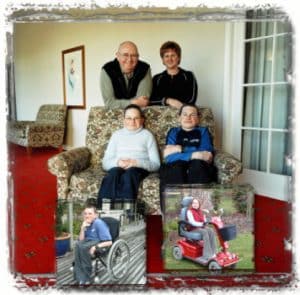
Postscript: Jenny gave voice to the quest she describes by becoming a member of ISMRD’s Board of Directors following the conclusion of the conference. She is also Secretary for Lysosomal Diseases New Zealand.
A Piece of Bad News… and A Piece of Good Luck! (by Sonja Woolley, Alpha-Mannosidosis Parent)
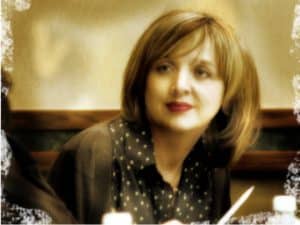
My name is Sonja Woolley and I live on the outskirts of London in the UK with my husband Martin, our five year old son Reuben and our daughter Saffron (Saffy, Princess Peach or Nutjob – according to behaviour) who has just turned three.
We took a body blow in late February of this year when Saffy was diagnosed with Alpha Mannosidosis. Whilst we were reeling from this news my sister Paula, more pragmatically, found the wonderful ISMRD website, learned about the forthcoming conference and started correspondence with Paul Murphy. Challenged by her commitment that if we didn’t travel to Rockville she would do so on our behalf, we booked our tickets and prepared to educate ourselves in a disease that very few doctors had any knowledge of.
It should be stated that our biological, or for that matter scientific, knowledge is extremely scant. For my part I had never even heard of the lysosome and had to raise a quizzical eyebrow when a local health professional commiserated with me on my daughter’s metabolic disease – I had no idea she had one!
A quick glance at the agenda for the conference ensured us we would gain a swift and expert introduction to the specifics of Saffy’s condition, but for us the greatest pull was the chance to meet the other Alpha Mannosidosis children and their families. The state of Saffy’s glue-filled ears made a pressurized cabin quite out of the question, so we reluctantly left the children at home.
Conference Highlights
Moments of hope
- Charles Peter’s presentation on the positive effects of BMT’s on Alpha Mannosidosis children felt like someone had just turned the lights back on. Learning that the mental deterioration had been halted and some of the physical symptoms lessened amongst his patients started a dream which still gets me out of bed every morning.
- Emil Kakkis’ presentation about the fantastic results of Enzyme Replacement Therapy in MPS kids gave great hope for the future ….. and brought home just how important having money is, even where it should matter least.
- Meeting Danielle Forsman, whose daughter has Alpha Mannosidosis, is a year older than Saffy and is now over 6 months post transplant. Danielle was a fantastic source of information and inspiration!
- Morton Cowan gave a presentation which simplified the bone marrow process and then had the generosity to sit with myself and Martin for over two hours while we fired questions at him.
Moments of awe
- Being told that the gathering of 16 parents/relations/carers of Alpha Mannosidosis children was the largest ever in the world was staggering. Our 5 week thirst for knowledge paled into insignificance by the stories we heard of misdiagnosis, bungled opportunities and misplaced advice.
- Marc Patterson and Dag Malm giving brilliant presentations to the family conference on the more practical issues of actually dealing with our children’s diseases day-in and day-out.
- Kelley Moreman being smart enough to make us all think understanding storage diseases isn’t that hard!
Moments of mirth
- Following the first morning of advanced bio chemistry we were able to assure the French mum, Anne Grégoriadès, sitting behind us that her lack of English may not be the barrier she anticipated – we hadn’t understood a word that had been said either!
And finally, and undoubtedly at the forefront of my mind John Forman serenading myself and Martin in the Doubletree bar with an unmatchable edition of “You’ll never walk alone” – ably accompanied by the giggles of Jenny and Paul Noble! Thank-you John!
Our recent diagnosis, Saffy’s age and relatively mild symptoms to date all put us in a unique position at the conference. We had come seeking the answers to many questions and we had found them. We had boarded the plane to Washington D.C. considering ourselves unusually unlucky and very isolated by the rarity of Saffy’s condition. Six days later (and with considerably more luggage courtesy of Toys-R-Us) we started our trip home feeling that the hard work of the scientific and medical professions meant that we had options to vastly improve Saffy’s life. Mainly we knew that the commitment and dedication of a group of parents in realising this conference, some that have been cruelly denied our options by time alone, had left us with a debt we will never be able to repay.
How Could I Not Attend? (by Bill Skojec, Sialidosis Parent)
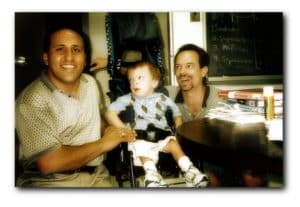
I am writing to share my experiences regarding the first ever International ISMRD conference which addressed the genetic lysosomal storage disorders that plague families like mine who were gathered together. I was there on behalf of my son, Alexander, who has Sialidosis Type II. Alex was not able to attend the conference as a result of illness. In fact, I was contemplating not attending the conference, as I was also ill at the time and had actually called in sick to work the first morning of the conference. However, as I sat in bed that morning weighing if I should go or not, some very clear thoughts came to me. First, and foremost, was the thought that my son had sacrificed so much to this disorder and remained an inspiration to me and all of those who work with him. How could I not attend? The second thought was that I would be missing the opportunity to meet with some of the people I have corresponded with via the internet and telephone for some four years now. Again, how could I not attend? My final thought was that I would be missing the most important research in this area by some of the greatest minds in the world today. I could not pass up such an opportunity so I did attend the conference and the experience was among the most valuable to me in my entire life. I would like to tell you why this had such a profound affect on me.
The conference was a huge success in my eyes because it brought families like mine together with each other and also with the dedicated, hard-working researchers trying to make a difference with these disorders. I felt a strong bond with the other families as we sat and shared our stories. Many of these families had traveled great distances to attend this event. It was especially meaningful to me to meet Zeny Christian, who had the strength and inner fortitude to attend the conference despite having lost her granddaughter to Sialidosis. We shared our experiences and looked hopefully to a future where families would not have to face such loss. I was also happy to have the opportunity to see Ida Ryan, Perry Huneault, and their son, Tyler, again. Tyler has Sialidosis and was born two weeks apart from my son Alexander. We have tried to catch up with each other every year at Dr. Suleiman Igdoura’s laboratory in Hamilton, Ontario. Dr. Igdoura is also researching possible genetic therapies for Sialidosis.
There were many researchers present who offered us some hope and optimism that there would one day be a cure for these disorders. None more relevant to my son, than Dr. Alessandra d’Azzo, who took the time to spend an afternoon with the families like mine who had children afflicted with Sialidosis. Her dedication and devotion to finding a cure for this disorder were as apparent as her warmth and compassion. I was moved by the fact that she understood the pain we all carried and did not just stick with research findings in detached manner. We are truly lucky to have persons like her involved in this research.
My final thoughts about the conference concern Paul Murphy, the president of ISMRD, and the other board members who devote their time to these disorders. I had contacted Paul four years before when my journey with Sialidosis began. He was one of my first contacts in those days and was instrumental in helping me find others to talk with and share my experiences. He also created Alexander’s Hope – a webpage that continues to be part of the ISMRD site. This webpage with our story has put me in contact with people from all over the world who have children diagnosed with Sialidosis. Until I met him at the conference, I had no idea how much time and hard work he devoted to ISMRD. His efforts regarding these disorders afflicting our children are truly amazing and I would like to tell him how grateful I am for all he has done. I would take part in another conference without reservation and look to the future with hope and optimism that one day a cure will be found.
A Home at Last! (by Brenda Haggett, Mucolipidosis III Parent)

Well, where to begin? My name is Brenda Haggett and my husband John and I have a little boy named Zach who was diagnosed with Mucolipidosis type III, or Pseudo-Hurler Polydystrophy, just about a year ago. Getting a diagnosis was not a surprise to us, as we had been told the morning we were to leave the hospital with our newborn baby that there was speculation that something was seriously wrong with him. We were robbed of the genuine happiness our first born should have given us. Instead, we were enveloped with fear as to what might be wrong with this seemingly beautiful and quite perfect little boy we had waited nine long years to welcome into the world. We had been thrown into parenthood on guard and on defense from day one. So began the several years long journey to finding an answer.
It was May 2003 and my little trooper was now 2 years old, and making incredible strides with the daily visits from Early Intervention therapists. They quickly became the support and confidantes that John and I so desperately needed! It was they who exalted and delighted in the triumphs Zachie made, albeit much later than all his peers and our peers children, but equally amazing and triumphant in our eyes!!!! We were so sure that he would persevere no matter what the doctors came up with. So it was at this point. having finally became comfortable with the fact that our son was only “globally delayed” for unspecified reasons, that we had our bi-annual visit to the Genetics clinic. For 3 years, both John and I attended each and every visit together and heard nothing but the same: “well, he looks great so go home and we’ll see you again in six months.” Today was the first time I had ever come to a visit alone, as John had a conflict at work. Of course, this had to be the day I was told that they saw significant changes in Zach and needed to do some lab tests to confirm what they believed to be a diagnosis of MPS (Mucopolysaccharidoses).
I was utterly shocked and terrified to say the least! We went through the gamut of blood tests and urine samples only to hurry up and wait two very long weeks. Of course after sharing all of the gory details with my husband, the first thing we did was submerge ourselves into internet research of this “MPS” title. Anyone who has any knowledge of this cruel and unwaveringly incurable disease, can no doubt understand how unbelievably shocked and mortified we were to learn that our baby had this deadly disease. The days and hours couldn’t go by any slower. Just a week after the labs were sent out, my husband had an out of town business trip for three short days that just also happened to be Mother’s Day weekend. The mere thought of my child having such a life threatening illness immediately put every little thing in life into perspective. To this day, I have to thank God for at least allowing me to see these truths so as to be able to truly cherish every single moment that we share with each other. I couldn’t have enjoyed every moment of that Mother’s day more except maybe if John had been there to enjoy it with me. The following day it was back to business as usual and we were in the midst of physical therapy when the phone rang and I the heard the worst set of words in my life. “Mrs. Haggett we have the results from your son’s labs and he has a lysosomal storage disorder. The good news is that it is one of the milder ones, not MPS, but ML.” I remember them wanting to set up a meeting the next day and telling them I couldn’t have one until my husband returned which was not for several days. When I hung up the phone, the first day of the rest of our life began.
Life had never been sadder or more depressing than the next few months. We immediately did what I suspect just about every other parent does when newly diagnosed, assumed the position of fight or flight! In our case it most definitely seemed to be Fight! We became members of the National MPS Society and received all the information we could and searched nightly on the internet for everything ever published about Mucolipidosis (which we sadly we discovered was not very much)!! I made contact with another ML parent who was the first person that had any clue of what ML was! She was truly a lifeline for both of us. She helped us address our fears and feel as though we were not alone. Even with that one contact, however, we were alone in our own city where not even our doctors had experience with ML. This is not surprising, as there are probably less than a dozen affected children here in our country, and maybe a little more than that around the entire world. I must give credit to the MPS Society for having the bulk of information available to newly diagnosed families in search of answers. I must also be honest when I say that I really did not find much in the way of family support, due to the mere fact that there are so few children affected by ML.
To which I can now say my husband and I have finally found!!! All in part to ISMRD!
I do have to thank the MPS society for making our connection to the ISMRD possible. I received notice that the ISMRD would be broadening their organization’s umbrella to encompass more rare genetic disorders, and to our astonishment, that included both Mucolipidosis II (I-Cell Disease) and Pseudo-Hurler Polydystrophy. I couldn’t get to the ISMRD website fast enough to find out more! I then received the brochure informing us of the upcoming first ever conference. It promised the latest information on current research from professionals from around the world. After nearly a year of searching high and low for some sort of promise in the area of research and not being able to get a straight answer out of anyone in our immediate care, it took us all of maybe three seconds flat to decide we WERE coming!!!!
April couldn’t come soon enough and the idea of actually meeting other families with ML couldn’t be more exciting! When we first inquired about how many ML families might come we were told maybe three. Well, that was two more than we knew right now and was the best news we had heard in almost a year! So we were off, and after nine long hours in the car with a very exuberant three year old we were ready for sleep. Luckily enough we were blessed with having the company of our family “Rock”, John’s mother, who came with us so we would not have to worry about Zachie while we were in sessions. We began the next morning registering and getting our agendas for the next few days when to our delight, Paul Murphy pointed us in the direction of our new “family!”
There they were: the ever experienced couple with two adult children with ML and the mother of a little boy a few years older than Zach, a beautiful little girl and a handsome young boy who all looked almost identical to our son, all equipped with pictures and hugs to match. It was instantaneous. The wall we had spent a year sheltering ourselves behind from even our closest friends came immediately tumbling down. They know, they understand, they are us!!! I can’t tell you how amazing it was to finally be among someone that truly new my life! It was astronomical. The comparisons were shared, the fears were validated and the bond had been forged!!!! We spent the next four days inseparable with one another trying to learn every morsel of information and looking for any small light of hope from these scientific individuals who most certainly dedicate their souls to this work. After the initial “fish out of water” feeling, we began to understand the medical jargon with almost ease and actually felt ourselves compelled to push them even further. I am most confident that some of these doctors had second thoughts when the newly formed clan of ML families besieged them with our thoughts, ideas and concerns concerning research and possible treatments for our children. I think the most wonderful moment was when I realized that these people did not get upset with our anxiousness; they were actually refreshed and possibly even moved by our steadfastness and love for our children. They wanted to be here to meet with parents and see our children. This has never been the experience with any doctors prior to this. I have never been in the same room with so many people that actually wanted the same for my child as I myself do: a cure, nothing more, nothing less. This is by far the most incredible and moving feeling I think any parent of a child with special needs, much less a rare disorder, could possibly experience.
There were so many moments like this, though, throughout the conference. As we sat awaiting the topics that applied to our disease, we got the opportunity to learn about other rare diseases and realize just how similar the feelings of hopelessness and drive toward a cure are among each of our equally rare disorders. This may be the most defining point of the entire conference in that we all share the desire to find a cure for these innocent children and the only hope they have is what evolves from our drive to find the answers! This is what I myself brought away from this wonderful experience: that we can defeat these disorders, maybe not in time for our own children but possibly the next generation of those afflicted. This can be done if we work together for the sake of all of our children and stand as a united front against these disorders. I really am so honored to have been given the opportunity to express my concerns and hopes for the future and feel very united with not just the ML families but all the families we met at the conference.
Upon leaving this conference, full of so much hope and promise for my son’s future, I couldn’t wait to attend the next conference and visit with all of our new allies. Since returning home, we have kept in touch with all of our new family members almost daily thanks to the Penguin Café on the ISMRD website. This website has quickly become a daily ritual in our household and even more than that a feeling of community with the capability of becoming a way to become more involved in what I believe is truly where my heart is destined to be. We have the resolve to be globally connected and become an even stronger voice within the research community, if we can all just work together and do our part. I hope that everyone will take a few minutes to check out the Café and see just how much it has changed and how much support it can offer your family. I truly feel that we can achieve great things through ISMRD, which to me is a vehicle of hope and future flight for all of our beloved penguins!